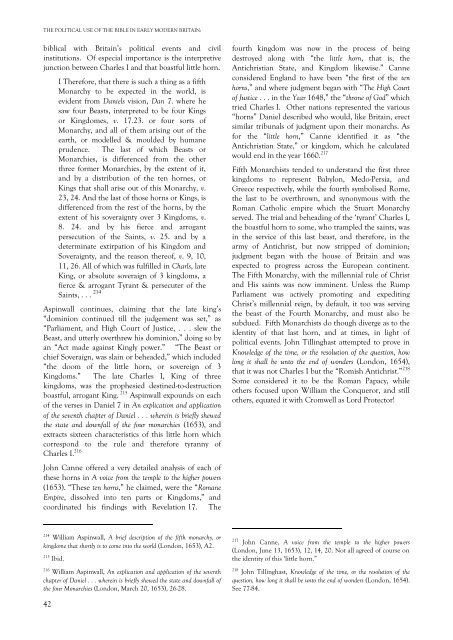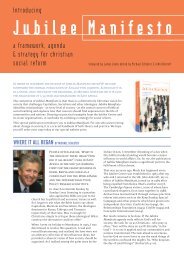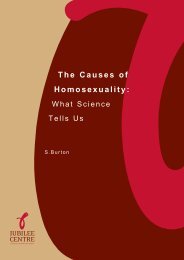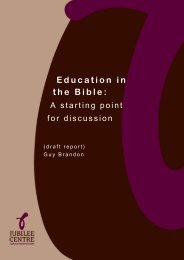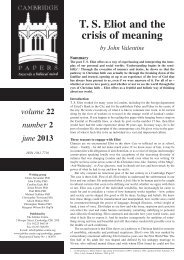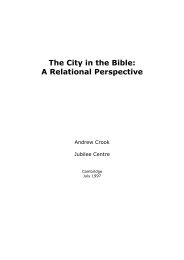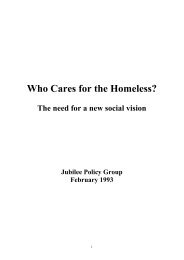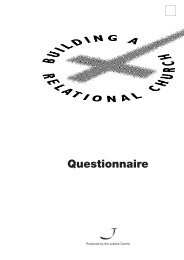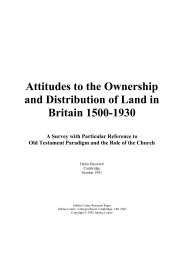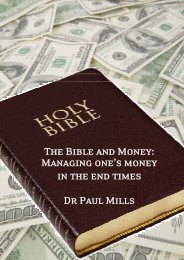Report Template - Jubilee Centre
Report Template - Jubilee Centre
Report Template - Jubilee Centre
You also want an ePaper? Increase the reach of your titles
YUMPU automatically turns print PDFs into web optimized ePapers that Google loves.
THE POLITICAL USE OF THE BIBLE IN EARLY MODERN BRITAIN:<br />
biblical with Britain’s political events and civil<br />
institutions. Of especial importance is the interpretive<br />
junction between Charles I and that boastful little horn.<br />
I Therefore, that there is such a thing as a fifth<br />
Monarchy to be expected in the world, is<br />
evident from Daniels vision, Dan 7. where he<br />
saw four Beasts, interpreted to be four Kings<br />
or Kingdomes, v. 17.23. or four sorts of<br />
Monarchy, and all of them arising out of the<br />
earth, or modelled & moulded by humane<br />
prudence. The last of which Beasts or<br />
Monarchies, is differenced from the other<br />
three former Monarchies, by the extent of it,<br />
and by a distribution of the ten hornes, or<br />
Kings that shall arise out of this Monarchy, v.<br />
23, 24. And the last of those horns or Kings, is<br />
differenced from the rest of the horns, by the<br />
extent of his soveraignty over 3 Kingdoms, v.<br />
8. 24. and by his fierce and arrogant<br />
persecution of the Saints, v. 25. and by a<br />
determinate extirpation of his Kingdom and<br />
Soveraignty, and the reason thereof, v. 9, 10,<br />
11, 26. All of which was fulfilled in Charls, late<br />
King, or absolute soveraign of 3 kingdoms, a<br />
fierce & arrogant Tyrant & persecuter of the<br />
Saints, . . . 214<br />
Aspinwall continues, claiming that the late king’s<br />
“dominion continued till the judgement was set,” as<br />
“Parliament, and High Court of Justice, . . . slew the<br />
Beast, and utterly overthrew his dominion,” doing so by<br />
an “Act made against Kingly power.” “The Beast or<br />
chief Soveraign, was slain or beheaded,” which included<br />
“the doom of the little horn, or sovereign of 3<br />
Kingdoms.” The late Charles I, King of three<br />
kingdoms, was the prophesied destined-to-destruction<br />
boastful, arrogant King. 215 Aspinwall expounds on each<br />
of the verses in Daniel 7 in An explication and application<br />
of the seventh chapter of Daniel . . . wherein is briefly shewed<br />
the state and downfall of the four monarchies (1653), and<br />
extracts sixteen characteristics of this little horn which<br />
correspond to the rule and therefore tyranny of<br />
Charles I. 216<br />
John Canne offered a very detailed analysis of each of<br />
these horns in A voice from the temple to the higher powers<br />
(1653). “These ten horns,” he claimed, were the “Romane<br />
Empire, dissolved into ten parts or Kingdoms,” and<br />
coordinated his findings with Revelation 17. The<br />
fourth kingdom was now in the process of being<br />
destroyed along with “the little horn, that is, the<br />
Antichristian State, and Kingdom likewise.” Canne<br />
considered England to have been “the first of the ten<br />
horns,” and where judgment began with “The High Court<br />
of Justice . . . in the Year 1648,” the “throne of God” which<br />
tried Charles I. Other nations represented the various<br />
“horns” Daniel described who would, like Britain, erect<br />
similar tribunals of judgment upon their monarchs. As<br />
for the “little horn,” Canne identified it as “the<br />
Antichristian State,” or kingdom, which he calculated<br />
would end in the year 1660. 217<br />
Fifth Monarchists tended to understand the first three<br />
kingdoms to represent Babylon, Medo-Persia, and<br />
Greece respectively, while the fourth symbolised Rome,<br />
the last to be overthrown, and synonymous with the<br />
Roman Catholic empire which the Stuart Monarchy<br />
served. The trial and beheading of the ‘tyrant’ Charles I,<br />
the boastful horn to some, who trampled the saints, was<br />
in the service of this last beast, and therefore, in the<br />
army of Antichrist, but now stripped of dominion;<br />
judgment began with the house of Britain and was<br />
expected to progress across the European continent.<br />
The Fifth Monarchy, with the millennial rule of Christ<br />
and His saints was now imminent. Unless the Rump<br />
Parliament was actively promoting and expediting<br />
Christ’s millennial reign, by default, it too was serving<br />
the beast of the Fourth Monarchy, and must also be<br />
subdued. Fifth Monarchists do though diverge as to the<br />
identity of that last horn, and at times, in light of<br />
political events. John Tillinghast attempted to prove in<br />
Knowledge of the time, or the resolution of the question, how<br />
long it shall be unto the end of wonders (London, 1654),<br />
that it was not Charles I but the “Romish Antichrist.” 218<br />
Some considered it to be the Roman Papacy, while<br />
others focused upon William the Conqueror, and still<br />
others, equated it with Cromwell as Lord Protector!<br />
214<br />
William Aspinwall, A brief description of the fifth monarchy, or<br />
kingdome that shortly is to come into the world (London, 1653), A2.<br />
215<br />
Ibid.<br />
216<br />
William Aspinwall, An explication and application of the seventh<br />
chapter of Daniel . . . wherein is briefly shewed the state and downfall of<br />
the four Monarchies (London, March 20, 1653), 26-28.<br />
217<br />
John Canne, A voice from the temple to the higher powers<br />
(London, June 13, 1653), 12, 14, 20. Not all agreed of course on<br />
the identity of this ‘little horn.”<br />
218<br />
John Tillinghast, Knowledge of the time, or the resolution of the<br />
question, how long it shall be unto the end of wonders (London, 1654).<br />
See 77-84.<br />
42


